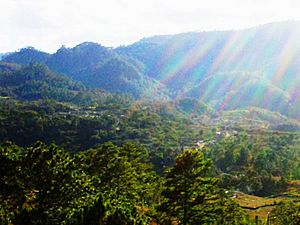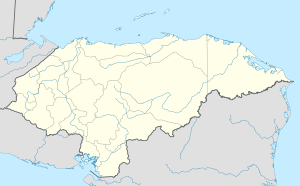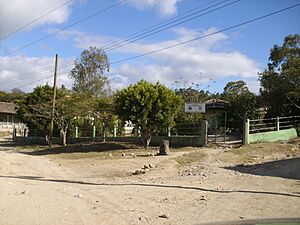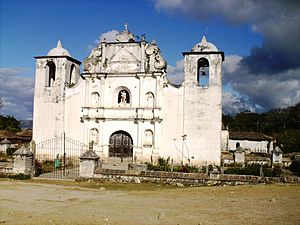San Sebastián, Lempira facts for kids
San Sebastián is a town and a municipality (which is like a local government area) in the Lempira Department of Honduras. It is located in the western part of Honduras. This area is quite isolated, meaning it's a bit far from other towns. San Sebastián is about 13 kilometers (around 8 miles) away from another town called San Manuel Colohete.
Contents
History of San Sebastián
San Sebastián has an interesting past. In a census taken in 1887, it was known as the village of Colosuca. It was part of a larger area called Gracias. Later, on March 7, 1896, Colosuca officially became its own municipality. The name "Colosuca" means "Beautiful Place."
Geography and Landscape
The main part of San Sebastián is located high up on a large mountain. This area is surrounded by many tall pine trees and some oak trees. The mountains here are very high and have steep slopes. In some places, the trees give way to smaller bushes and plants. The ground and rocks in this region were formed by volcanoes a long, long time ago.
Where is San Sebastián Located?
San Sebastián shares its borders with several other municipalities and even another department.
- To the North: It borders the San Manuel Colohete municipality and the Ocotepeque Department.
- To the South: It borders the Tomalá and San Andrés municipalities.
- To the East: It borders the La Campa and San Manuel Colohete municipalities.
- To the West: It borders the Guarita, Cololaca, and San Marcos de Caiquin municipalities.
The total area of San Sebastián is about 227 square kilometers (about 88 square miles).
Local Economy and Resources
The main way people in San Sebastián make a living is through growing coffee. Harvesting coffee provides many jobs for people who live here and even for those who come from other places. Raising cattle (like cows) is the second most important activity. Selling groceries to the city of Gracias is also a good way for people to earn money. Farmers also grow corn and beans, mostly to feed their own families.
In 2007, a new system was built to manage wastewater, which uses water from wells dug deep into the ground. San Sebastián also has electricity and mobile phone service. For transportation, there is one bus that travels between the municipality's main town and Gracias each day.
Population and People
In 2001, about 8,026 people lived in San Sebastián. By 2013, the population had grown to 10,453 people. The municipality is made up of 7 main villages and 108 smaller settlements.
Who Lives in San Sebastián?
Most of the people in San Sebastián are Indigenous, meaning they are descendants of the original people who lived in this land. About 89.83% of the population is Indigenous, with most of them being from the Lenca people. About 10% of the people are Mestizo, which means they have mixed European and Indigenous heritage. A very small number, about 0.17%, are Black or Afro-Honduran.
Visiting San Sebastián
If you want to visit San Sebastián, be prepared for an adventure! The roads can be narrow and steep, especially after you pass Colohete. It's best to use a vehicle with 4-wheel drive because the roads can be challenging.
You will need to cross two rivers. One river can only be crossed during the dry season when the water is low. The other river has a bridge you can use. As you travel, you can see the Congolon Mountain to the south and other mountains in Ocotepeque to the north.
The old church in San Sebastián is also a great reason to visit, especially if you enjoy seeing old buildings from colonial times. San Sebastián is part of the "Colosuca path," which is a special route organized by the national tourism institute. This path helps visitors learn about the rich history and culture of the Indigenous people in the area.
Local Celebrations
San Sebastián celebrates its local holiday, "San Sebastián Day," every year on January 20th.
Images for kids
See also
 In Spanish: San Sebastián (Lempira) para niños
In Spanish: San Sebastián (Lempira) para niños






